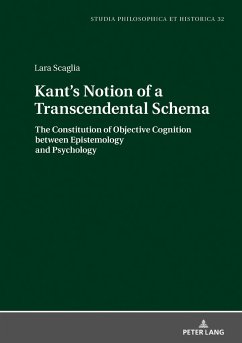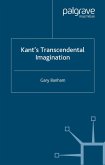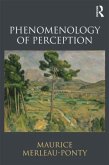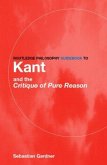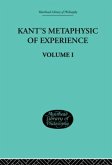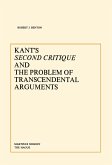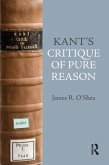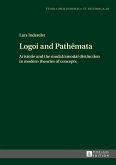Lara ScagliaThe Constitution of Objective Cognition between Epistemology and Psychology
Kant's Notion of a Transcendental Schema
The Constitution of Objective Cognition between Epistemology and Psychology
Herausgegeben:Kann, Christoph
Lara ScagliaThe Constitution of Objective Cognition between Epistemology and Psychology
Kant's Notion of a Transcendental Schema
The Constitution of Objective Cognition between Epistemology and Psychology
Herausgegeben:Kann, Christoph
- Gebundenes Buch
- Merkliste
- Auf die Merkliste
- Bewerten Bewerten
- Teilen
- Produkt teilen
- Produkterinnerung
- Produkterinnerung
The main aim of this book is to provide a critical and historical inquiry into Kant's schematism chapter contained in the Critique of Pure Reason. More specifically, the book argues that Kant's schematism chapter is a necessary step within the project of the Critique. It deals with a problem of its own, one which is not the object of the previous chapters: How can categories be applied to intuitions? The author shows that the term 'schema' has an interesting and long tradition of different philosophical uses that finds in the works of Kant a point of no-return. In the philosophical works…mehr
Andere Kunden interessierten sich auch für
![Kant's Transcendental Imagination Kant's Transcendental Imagination]() G. BanhamKant's Transcendental Imagination75,99 €
G. BanhamKant's Transcendental Imagination75,99 €![Phenomenology of Perception Phenomenology of Perception]() Maurice Merleau-PontyPhenomenology of Perception40,99 €
Maurice Merleau-PontyPhenomenology of Perception40,99 €![Routledge Philosophy GuideBook to Kant and the Critique of Pure Reason Routledge Philosophy GuideBook to Kant and the Critique of Pure Reason]() Sebastian GardnerRoutledge Philosophy GuideBook to Kant and the Critique of Pure Reason24,99 €
Sebastian GardnerRoutledge Philosophy GuideBook to Kant and the Critique of Pure Reason24,99 €![Kant's Metaphysic of Experience Kant's Metaphysic of Experience]() H J PatonKant's Metaphysic of Experience52,99 €
H J PatonKant's Metaphysic of Experience52,99 €![Kant's Second Critique and the Problem of Transcendental Arguments Kant's Second Critique and the Problem of Transcendental Arguments]() R. J. BentonKant's Second Critique and the Problem of Transcendental Arguments77,99 €
R. J. BentonKant's Second Critique and the Problem of Transcendental Arguments77,99 €![Kant's Critique of Pure Reason Kant's Critique of Pure Reason]() James O'SheaKant's Critique of Pure Reason37,99 €
James O'SheaKant's Critique of Pure Reason37,99 €![Logoi and Pathêmata Logoi and Pathêmata]() Lars InderelstLogoi and Pathêmata80,20 €
Lars InderelstLogoi and Pathêmata80,20 €-
-
-
The main aim of this book is to provide a critical and historical inquiry into Kant's schematism chapter contained in the Critique of Pure Reason. More specifically, the book argues that Kant's schematism chapter is a necessary step within the project of the Critique. It deals with a problem of its own, one which is not the object of the previous chapters: How can categories be applied to intuitions? The author shows that the term 'schema' has an interesting and long tradition of different philosophical uses that finds in the works of Kant a point of no-return. In the philosophical works written before Kant, the notion of schema did not have a specific and distinctive meaning and function of its own but was rather used in different contexts (from rhetoric to logic to psychology). After Kant, all philosophers who speak of schemata refer in one way or another back to Kant's distinctive notion, which possesses a specific, epistemic meaning. Moreover, this book aims to provide a contribution to the understanding of the relation between philosophy and the sciences. It is by means of demonstrating the importance of the schematism chapter not only within the Critique but also from a broader perspective, deriving from the fact that Kant's doctrine of schemata had an impressive influence not only on philosophers but also on psychologists.
Produktdetails
- Produktdetails
- Studia philosophica et historica 32
- Verlag: Peter Lang
- Artikelnr. des Verlages: 280438
- 1. Auflage
- Seitenzahl: 294
- Erscheinungstermin: 2. April 2020
- Englisch
- Abmessung: 216mm x 153mm x 21mm
- Gewicht: 451g
- ISBN-13: 9783631804384
- ISBN-10: 3631804385
- Artikelnr.: 59162933
- Herstellerkennzeichnung
- Lang, Peter GmbH
- Gontardstraße 11
- 10178 Berlin
- r.boehm-korff@peterlang.com
- Studia philosophica et historica 32
- Verlag: Peter Lang
- Artikelnr. des Verlages: 280438
- 1. Auflage
- Seitenzahl: 294
- Erscheinungstermin: 2. April 2020
- Englisch
- Abmessung: 216mm x 153mm x 21mm
- Gewicht: 451g
- ISBN-13: 9783631804384
- ISBN-10: 3631804385
- Artikelnr.: 59162933
- Herstellerkennzeichnung
- Lang, Peter GmbH
- Gontardstraße 11
- 10178 Berlin
- r.boehm-korff@peterlang.com
After her master¿s studies in Milan, Lara Scaglia completed her PhD at the Universitat Autònoma de Barcelona (UAB), Spain, under the supervision of professor Thomas Sturm. She collaborated with the Centre d`Història de la Ciència (CEHIC) and was a visiting fellow at the Collaborative Research Centre SFB 991 ¿The Structure of Representations in Language, Cognition, and Science` at Heinrich-Heine-Universität Düsseldorf, Germany, and a postdoc DAAD fellow at the Goethe University Frankfurt, Germany.
Introduction .............................................................................................................. 15
Main objectives of the study ................................................................................... 15
Method ...................................................................................................................... 17
State of the art ........................................................................................................... 18
Structure .................................................................................................................... 20
Part I: Kant's theory of schematism and its context ....................................... 21
1. The notion of schema before Kant .................................................................... 23
1.1 Ancient times ................................................................................................ 24
1.2 Middle Ages .................................................................................................. 26
1.3 Modern Ages ................................................................................................ 28
1.3.1 Tetens's conception of schema ............................................................ 34
1.4 Conclusion .................................................................................................... 40
2. Kant's pre-critical notion of schema ................................................................. 41
2.1 The metaphysical notion of schema in the Nova Dilucidatio ................. 45
2.2 The new significance of schema in the Dissertation from 1770.
A first reference to the problem of objectivity ......................................... 46
2.2.1 Schema and the forms of the worlds ................................................. 47
2.2.2 The novelty of the account of space and time as schemata in
the Dissertation: Comparison with Newton and Leibniz ............... 52
2.2.3 The limitations of Kant's Dissertation and the need of a
further solution to the question of objectivity .................................. 54
3. The introduction of the transcendental forms in the Critique of Pure
Reason ................................................................................................................... 57
3.1 The doctrine of sensibility .......................................................................... 58
3.2 The doctrine of the understanding ............................................................ 63
4. Analysis of the schematism chapter ................................................................. 73
4.1 The Transcendental Doctrine of Judgement ............................................ 74
4.2 Time-mediation ........................................................................................... 78
4.3 Schemata and their faculty ......................................................................... 80
4.4 Schemata: images or concepts? .................................................................. 82
4.5 The table of schemata .................................................................................. 84
4.6 Schemata as conditions of the significance of the pure concepts .......... 89
5. Debates over the schematism chapter in Kantian scholarship ...................... 95
5.1 Main criticisms of the schematism chapter .............................................. 96
5.1.1 A redundant addition within the Critique of Pure Reason ............. 96
a) Zschocke's focus on the Transcendental Aesthetic ..................... 96
b) Curtius: the schematism chapter and 24 .................................. 98
5.1.2 Schematism's obscure terminology .................................................. 100
a) Curtius: difficulties concerning the notion of
subsumption .................................................................................. 100
b) Walsh: schemata and concepts .................................................... 103
c) Guyer: incongruences in the relation between categories
and schemata ......................................................................... 104
d) Allison: difficulties concerning the distinctions among
faculties and the variety of schemata's definitions ............ 106
5.1.3 The priority ascribed to time over space ......................................... 109
a) Zschocke's criticism of time as being the only mediating
function .................................................................................. 109
b) Walsh's introduction of "organic" schemata .............................. 109
c) Guyer: Schemata and temporality .............................................. 110
5.2 In response to the criticisms of the schematism chapter ...................... 113
5.2.1 The necessity of schematism in the Critique of Pure Reason ........ 113
a) The distinction between the function of the
Transcendental Deduction and the task of the
schematism chapter .............................................................. 113
b) "Knowing that and knowing how" ............................................. 116 5.2.2 The obscurity of the chapter ............................................................. 122
a) Subsumption .................................................................................. 122
b) "To be" and "to do": defining schemata ..................................... 125
c) The distinction between categories and forms of intuition ..... 128
d) Categories and schemata ............................................................. 130
e) Schemata and principles .............................................................. 132
f) Schemata and ideas ....................................................................... 134
g) Judgement and its role between reason and understanding ... 138
5.2.3 Space and time .................................................................................... 141
a) Time, at least .................................................................................. 141
b) Dynamic schemata ....................................................................... 142
c) Difficulties within Kant's text ...................................................... 142
Part II: After Kant ................................................................................................ 147
1. The philosophical reception and criticism of the schematism chapter ..... 149
1.1 The earliest receptions of Kant's schematism chapter ........................... 150
1.2 Idealism and post-Kantianism ................................................................. 152
1.3 From the late nineteenth to the early twentieth century ...................... 159
2. Kant's distinction between philosophy and psychology .............................. 177
2.1 Philosophy as a system of concepts ......................................................... 178
2.2 Psychology: a doctrine of the inner sense .............................................. 186
2.3 Is Kant a transcendental psychologist? ................................................... 194
3. Kant's notion of a schema in twentieth-century psychology ...................... 201
3.1 Schema theories ......................................................................................... 201
3.2 Frederic Bartlett ......................................................................................... 206
3.2.1 A pioneer of applied psychology ...................................................... 207
3.2.2 Experimental method ........................................................................ 208
3.2.3 The topics of experiments ................................................................. 209
3.2.4 Remembering ..................................................................................... 210
3.2.5 Schematic settings .............................................................................. 210
3.2.6 Meaning ............................................................................................... 214
3.2.7 Conclusion .......................................................................................... 217
3.3 Jean Piaget's interpretation of Kant's notion of a schema ..................... 219
3.3.1 An interest in both theoretical and empirical studies ................... 220
3.3.2 A "philosophical shock" .................................................................... 222
3.3.3 Piaget's notion of schemata ............................................................... 224
3.3.4 An example of a schema: the object ................................................ 226
3.3.5 Experience as an organisation through schemata. Piaget's
perspective between empiricism and apriorism ............................. 232
3.3.6 Piaget's novelty and difference from Kant's view ........................... 234
3.4 Lawrence Barsalou's reception of Kant's
transcendental schematism ...................................................................... 238
3.4.1 Cognitive psychology ........................................................................ 239
3.4.2 Categorisation ..................................................................................... 240
3.4.3 Modal theory versus amodal theory ................................................ 241
3.4.4 Properties ............................................................................................ 244
a) Neural representations ................................................................. 244
b) Schematic perceptual symbols .................................................... 244
c) Multimodal symbols ..................................................................... 245
d) Simulators ...................................................................................... 245
e) Frames ............................................................................................ 247
f) Linguistic indexing and control .................................................. 248
3.4.5 Barsalou and Kant .............................................................................. 249
3.4.6 Psychology and philosophy .............................................................. 250
Conclusion .............................................................................................................. 253
Schema: the history of an idea ......................................................................... 253
The function of schematism ............................................................................. 255
Schematisms's legacy between philosophy and psychology ........................ 258
New perspectives ............................................................................................... 264
Bibliography ............................................................................................................ 267
Lists of abbreviations for classical works ........................................................ 267
Primary literature .............................................................................................. 267
Secondary literature .......................................................................................... 273
Online resources ................................................................................................ 283
List of figures ........................................................................................................... 285
List of tables ............................................................................................................ 287
Index ........................................................................................................................ 289
Main objectives of the study ................................................................................... 15
Method ...................................................................................................................... 17
State of the art ........................................................................................................... 18
Structure .................................................................................................................... 20
Part I: Kant's theory of schematism and its context ....................................... 21
1. The notion of schema before Kant .................................................................... 23
1.1 Ancient times ................................................................................................ 24
1.2 Middle Ages .................................................................................................. 26
1.3 Modern Ages ................................................................................................ 28
1.3.1 Tetens's conception of schema ............................................................ 34
1.4 Conclusion .................................................................................................... 40
2. Kant's pre-critical notion of schema ................................................................. 41
2.1 The metaphysical notion of schema in the Nova Dilucidatio ................. 45
2.2 The new significance of schema in the Dissertation from 1770.
A first reference to the problem of objectivity ......................................... 46
2.2.1 Schema and the forms of the worlds ................................................. 47
2.2.2 The novelty of the account of space and time as schemata in
the Dissertation: Comparison with Newton and Leibniz ............... 52
2.2.3 The limitations of Kant's Dissertation and the need of a
further solution to the question of objectivity .................................. 54
3. The introduction of the transcendental forms in the Critique of Pure
Reason ................................................................................................................... 57
3.1 The doctrine of sensibility .......................................................................... 58
3.2 The doctrine of the understanding ............................................................ 63
4. Analysis of the schematism chapter ................................................................. 73
4.1 The Transcendental Doctrine of Judgement ............................................ 74
4.2 Time-mediation ........................................................................................... 78
4.3 Schemata and their faculty ......................................................................... 80
4.4 Schemata: images or concepts? .................................................................. 82
4.5 The table of schemata .................................................................................. 84
4.6 Schemata as conditions of the significance of the pure concepts .......... 89
5. Debates over the schematism chapter in Kantian scholarship ...................... 95
5.1 Main criticisms of the schematism chapter .............................................. 96
5.1.1 A redundant addition within the Critique of Pure Reason ............. 96
a) Zschocke's focus on the Transcendental Aesthetic ..................... 96
b) Curtius: the schematism chapter and 24 .................................. 98
5.1.2 Schematism's obscure terminology .................................................. 100
a) Curtius: difficulties concerning the notion of
subsumption .................................................................................. 100
b) Walsh: schemata and concepts .................................................... 103
c) Guyer: incongruences in the relation between categories
and schemata ......................................................................... 104
d) Allison: difficulties concerning the distinctions among
faculties and the variety of schemata's definitions ............ 106
5.1.3 The priority ascribed to time over space ......................................... 109
a) Zschocke's criticism of time as being the only mediating
function .................................................................................. 109
b) Walsh's introduction of "organic" schemata .............................. 109
c) Guyer: Schemata and temporality .............................................. 110
5.2 In response to the criticisms of the schematism chapter ...................... 113
5.2.1 The necessity of schematism in the Critique of Pure Reason ........ 113
a) The distinction between the function of the
Transcendental Deduction and the task of the
schematism chapter .............................................................. 113
b) "Knowing that and knowing how" ............................................. 116 5.2.2 The obscurity of the chapter ............................................................. 122
a) Subsumption .................................................................................. 122
b) "To be" and "to do": defining schemata ..................................... 125
c) The distinction between categories and forms of intuition ..... 128
d) Categories and schemata ............................................................. 130
e) Schemata and principles .............................................................. 132
f) Schemata and ideas ....................................................................... 134
g) Judgement and its role between reason and understanding ... 138
5.2.3 Space and time .................................................................................... 141
a) Time, at least .................................................................................. 141
b) Dynamic schemata ....................................................................... 142
c) Difficulties within Kant's text ...................................................... 142
Part II: After Kant ................................................................................................ 147
1. The philosophical reception and criticism of the schematism chapter ..... 149
1.1 The earliest receptions of Kant's schematism chapter ........................... 150
1.2 Idealism and post-Kantianism ................................................................. 152
1.3 From the late nineteenth to the early twentieth century ...................... 159
2. Kant's distinction between philosophy and psychology .............................. 177
2.1 Philosophy as a system of concepts ......................................................... 178
2.2 Psychology: a doctrine of the inner sense .............................................. 186
2.3 Is Kant a transcendental psychologist? ................................................... 194
3. Kant's notion of a schema in twentieth-century psychology ...................... 201
3.1 Schema theories ......................................................................................... 201
3.2 Frederic Bartlett ......................................................................................... 206
3.2.1 A pioneer of applied psychology ...................................................... 207
3.2.2 Experimental method ........................................................................ 208
3.2.3 The topics of experiments ................................................................. 209
3.2.4 Remembering ..................................................................................... 210
3.2.5 Schematic settings .............................................................................. 210
3.2.6 Meaning ............................................................................................... 214
3.2.7 Conclusion .......................................................................................... 217
3.3 Jean Piaget's interpretation of Kant's notion of a schema ..................... 219
3.3.1 An interest in both theoretical and empirical studies ................... 220
3.3.2 A "philosophical shock" .................................................................... 222
3.3.3 Piaget's notion of schemata ............................................................... 224
3.3.4 An example of a schema: the object ................................................ 226
3.3.5 Experience as an organisation through schemata. Piaget's
perspective between empiricism and apriorism ............................. 232
3.3.6 Piaget's novelty and difference from Kant's view ........................... 234
3.4 Lawrence Barsalou's reception of Kant's
transcendental schematism ...................................................................... 238
3.4.1 Cognitive psychology ........................................................................ 239
3.4.2 Categorisation ..................................................................................... 240
3.4.3 Modal theory versus amodal theory ................................................ 241
3.4.4 Properties ............................................................................................ 244
a) Neural representations ................................................................. 244
b) Schematic perceptual symbols .................................................... 244
c) Multimodal symbols ..................................................................... 245
d) Simulators ...................................................................................... 245
e) Frames ............................................................................................ 247
f) Linguistic indexing and control .................................................. 248
3.4.5 Barsalou and Kant .............................................................................. 249
3.4.6 Psychology and philosophy .............................................................. 250
Conclusion .............................................................................................................. 253
Schema: the history of an idea ......................................................................... 253
The function of schematism ............................................................................. 255
Schematisms's legacy between philosophy and psychology ........................ 258
New perspectives ............................................................................................... 264
Bibliography ............................................................................................................ 267
Lists of abbreviations for classical works ........................................................ 267
Primary literature .............................................................................................. 267
Secondary literature .......................................................................................... 273
Online resources ................................................................................................ 283
List of figures ........................................................................................................... 285
List of tables ............................................................................................................ 287
Index ........................................................................................................................ 289
Introduction .............................................................................................................. 15
Main objectives of the study ................................................................................... 15
Method ...................................................................................................................... 17
State of the art ........................................................................................................... 18
Structure .................................................................................................................... 20
Part I: Kant's theory of schematism and its context ....................................... 21
1. The notion of schema before Kant .................................................................... 23
1.1 Ancient times ................................................................................................ 24
1.2 Middle Ages .................................................................................................. 26
1.3 Modern Ages ................................................................................................ 28
1.3.1 Tetens's conception of schema ............................................................ 34
1.4 Conclusion .................................................................................................... 40
2. Kant's pre-critical notion of schema ................................................................. 41
2.1 The metaphysical notion of schema in the Nova Dilucidatio ................. 45
2.2 The new significance of schema in the Dissertation from 1770.
A first reference to the problem of objectivity ......................................... 46
2.2.1 Schema and the forms of the worlds ................................................. 47
2.2.2 The novelty of the account of space and time as schemata in
the Dissertation: Comparison with Newton and Leibniz ............... 52
2.2.3 The limitations of Kant's Dissertation and the need of a
further solution to the question of objectivity .................................. 54
3. The introduction of the transcendental forms in the Critique of Pure
Reason ................................................................................................................... 57
3.1 The doctrine of sensibility .......................................................................... 58
3.2 The doctrine of the understanding ............................................................ 63
4. Analysis of the schematism chapter ................................................................. 73
4.1 The Transcendental Doctrine of Judgement ............................................ 74
4.2 Time-mediation ........................................................................................... 78
4.3 Schemata and their faculty ......................................................................... 80
4.4 Schemata: images or concepts? .................................................................. 82
4.5 The table of schemata .................................................................................. 84
4.6 Schemata as conditions of the significance of the pure concepts .......... 89
5. Debates over the schematism chapter in Kantian scholarship ...................... 95
5.1 Main criticisms of the schematism chapter .............................................. 96
5.1.1 A redundant addition within the Critique of Pure Reason ............. 96
a) Zschocke's focus on the Transcendental Aesthetic ..................... 96
b) Curtius: the schematism chapter and 24 .................................. 98
5.1.2 Schematism's obscure terminology .................................................. 100
a) Curtius: difficulties concerning the notion of
subsumption .................................................................................. 100
b) Walsh: schemata and concepts .................................................... 103
c) Guyer: incongruences in the relation between categories
and schemata ......................................................................... 104
d) Allison: difficulties concerning the distinctions among
faculties and the variety of schemata's definitions ............ 106
5.1.3 The priority ascribed to time over space ......................................... 109
a) Zschocke's criticism of time as being the only mediating
function .................................................................................. 109
b) Walsh's introduction of "organic" schemata .............................. 109
c) Guyer: Schemata and temporality .............................................. 110
5.2 In response to the criticisms of the schematism chapter ...................... 113
5.2.1 The necessity of schematism in the Critique of Pure Reason ........ 113
a) The distinction between the function of the
Transcendental Deduction and the task of the
schematism chapter .............................................................. 113
b) "Knowing that and knowing how" ............................................. 116 5.2.2 The obscurity of the chapter ............................................................. 122
a) Subsumption .................................................................................. 122
b) "To be" and "to do": defining schemata ..................................... 125
c) The distinction between categories and forms of intuition ..... 128
d) Categories and schemata ............................................................. 130
e) Schemata and principles .............................................................. 132
f) Schemata and ideas ....................................................................... 134
g) Judgement and its role between reason and understanding ... 138
5.2.3 Space and time .................................................................................... 141
a) Time, at least .................................................................................. 141
b) Dynamic schemata ....................................................................... 142
c) Difficulties within Kant's text ...................................................... 142
Part II: After Kant ................................................................................................ 147
1. The philosophical reception and criticism of the schematism chapter ..... 149
1.1 The earliest receptions of Kant's schematism chapter ........................... 150
1.2 Idealism and post-Kantianism ................................................................. 152
1.3 From the late nineteenth to the early twentieth century ...................... 159
2. Kant's distinction between philosophy and psychology .............................. 177
2.1 Philosophy as a system of concepts ......................................................... 178
2.2 Psychology: a doctrine of the inner sense .............................................. 186
2.3 Is Kant a transcendental psychologist? ................................................... 194
3. Kant's notion of a schema in twentieth-century psychology ...................... 201
3.1 Schema theories ......................................................................................... 201
3.2 Frederic Bartlett ......................................................................................... 206
3.2.1 A pioneer of applied psychology ...................................................... 207
3.2.2 Experimental method ........................................................................ 208
3.2.3 The topics of experiments ................................................................. 209
3.2.4 Remembering ..................................................................................... 210
3.2.5 Schematic settings .............................................................................. 210
3.2.6 Meaning ............................................................................................... 214
3.2.7 Conclusion .......................................................................................... 217
3.3 Jean Piaget's interpretation of Kant's notion of a schema ..................... 219
3.3.1 An interest in both theoretical and empirical studies ................... 220
3.3.2 A "philosophical shock" .................................................................... 222
3.3.3 Piaget's notion of schemata ............................................................... 224
3.3.4 An example of a schema: the object ................................................ 226
3.3.5 Experience as an organisation through schemata. Piaget's
perspective between empiricism and apriorism ............................. 232
3.3.6 Piaget's novelty and difference from Kant's view ........................... 234
3.4 Lawrence Barsalou's reception of Kant's
transcendental schematism ...................................................................... 238
3.4.1 Cognitive psychology ........................................................................ 239
3.4.2 Categorisation ..................................................................................... 240
3.4.3 Modal theory versus amodal theory ................................................ 241
3.4.4 Properties ............................................................................................ 244
a) Neural representations ................................................................. 244
b) Schematic perceptual symbols .................................................... 244
c) Multimodal symbols ..................................................................... 245
d) Simulators ...................................................................................... 245
e) Frames ............................................................................................ 247
f) Linguistic indexing and control .................................................. 248
3.4.5 Barsalou and Kant .............................................................................. 249
3.4.6 Psychology and philosophy .............................................................. 250
Conclusion .............................................................................................................. 253
Schema: the history of an idea ......................................................................... 253
The function of schematism ............................................................................. 255
Schematisms's legacy between philosophy and psychology ........................ 258
New perspectives ............................................................................................... 264
Bibliography ............................................................................................................ 267
Lists of abbreviations for classical works ........................................................ 267
Primary literature .............................................................................................. 267
Secondary literature .......................................................................................... 273
Online resources ................................................................................................ 283
List of figures ........................................................................................................... 285
List of tables ............................................................................................................ 287
Index ........................................................................................................................ 289
Main objectives of the study ................................................................................... 15
Method ...................................................................................................................... 17
State of the art ........................................................................................................... 18
Structure .................................................................................................................... 20
Part I: Kant's theory of schematism and its context ....................................... 21
1. The notion of schema before Kant .................................................................... 23
1.1 Ancient times ................................................................................................ 24
1.2 Middle Ages .................................................................................................. 26
1.3 Modern Ages ................................................................................................ 28
1.3.1 Tetens's conception of schema ............................................................ 34
1.4 Conclusion .................................................................................................... 40
2. Kant's pre-critical notion of schema ................................................................. 41
2.1 The metaphysical notion of schema in the Nova Dilucidatio ................. 45
2.2 The new significance of schema in the Dissertation from 1770.
A first reference to the problem of objectivity ......................................... 46
2.2.1 Schema and the forms of the worlds ................................................. 47
2.2.2 The novelty of the account of space and time as schemata in
the Dissertation: Comparison with Newton and Leibniz ............... 52
2.2.3 The limitations of Kant's Dissertation and the need of a
further solution to the question of objectivity .................................. 54
3. The introduction of the transcendental forms in the Critique of Pure
Reason ................................................................................................................... 57
3.1 The doctrine of sensibility .......................................................................... 58
3.2 The doctrine of the understanding ............................................................ 63
4. Analysis of the schematism chapter ................................................................. 73
4.1 The Transcendental Doctrine of Judgement ............................................ 74
4.2 Time-mediation ........................................................................................... 78
4.3 Schemata and their faculty ......................................................................... 80
4.4 Schemata: images or concepts? .................................................................. 82
4.5 The table of schemata .................................................................................. 84
4.6 Schemata as conditions of the significance of the pure concepts .......... 89
5. Debates over the schematism chapter in Kantian scholarship ...................... 95
5.1 Main criticisms of the schematism chapter .............................................. 96
5.1.1 A redundant addition within the Critique of Pure Reason ............. 96
a) Zschocke's focus on the Transcendental Aesthetic ..................... 96
b) Curtius: the schematism chapter and 24 .................................. 98
5.1.2 Schematism's obscure terminology .................................................. 100
a) Curtius: difficulties concerning the notion of
subsumption .................................................................................. 100
b) Walsh: schemata and concepts .................................................... 103
c) Guyer: incongruences in the relation between categories
and schemata ......................................................................... 104
d) Allison: difficulties concerning the distinctions among
faculties and the variety of schemata's definitions ............ 106
5.1.3 The priority ascribed to time over space ......................................... 109
a) Zschocke's criticism of time as being the only mediating
function .................................................................................. 109
b) Walsh's introduction of "organic" schemata .............................. 109
c) Guyer: Schemata and temporality .............................................. 110
5.2 In response to the criticisms of the schematism chapter ...................... 113
5.2.1 The necessity of schematism in the Critique of Pure Reason ........ 113
a) The distinction between the function of the
Transcendental Deduction and the task of the
schematism chapter .............................................................. 113
b) "Knowing that and knowing how" ............................................. 116 5.2.2 The obscurity of the chapter ............................................................. 122
a) Subsumption .................................................................................. 122
b) "To be" and "to do": defining schemata ..................................... 125
c) The distinction between categories and forms of intuition ..... 128
d) Categories and schemata ............................................................. 130
e) Schemata and principles .............................................................. 132
f) Schemata and ideas ....................................................................... 134
g) Judgement and its role between reason and understanding ... 138
5.2.3 Space and time .................................................................................... 141
a) Time, at least .................................................................................. 141
b) Dynamic schemata ....................................................................... 142
c) Difficulties within Kant's text ...................................................... 142
Part II: After Kant ................................................................................................ 147
1. The philosophical reception and criticism of the schematism chapter ..... 149
1.1 The earliest receptions of Kant's schematism chapter ........................... 150
1.2 Idealism and post-Kantianism ................................................................. 152
1.3 From the late nineteenth to the early twentieth century ...................... 159
2. Kant's distinction between philosophy and psychology .............................. 177
2.1 Philosophy as a system of concepts ......................................................... 178
2.2 Psychology: a doctrine of the inner sense .............................................. 186
2.3 Is Kant a transcendental psychologist? ................................................... 194
3. Kant's notion of a schema in twentieth-century psychology ...................... 201
3.1 Schema theories ......................................................................................... 201
3.2 Frederic Bartlett ......................................................................................... 206
3.2.1 A pioneer of applied psychology ...................................................... 207
3.2.2 Experimental method ........................................................................ 208
3.2.3 The topics of experiments ................................................................. 209
3.2.4 Remembering ..................................................................................... 210
3.2.5 Schematic settings .............................................................................. 210
3.2.6 Meaning ............................................................................................... 214
3.2.7 Conclusion .......................................................................................... 217
3.3 Jean Piaget's interpretation of Kant's notion of a schema ..................... 219
3.3.1 An interest in both theoretical and empirical studies ................... 220
3.3.2 A "philosophical shock" .................................................................... 222
3.3.3 Piaget's notion of schemata ............................................................... 224
3.3.4 An example of a schema: the object ................................................ 226
3.3.5 Experience as an organisation through schemata. Piaget's
perspective between empiricism and apriorism ............................. 232
3.3.6 Piaget's novelty and difference from Kant's view ........................... 234
3.4 Lawrence Barsalou's reception of Kant's
transcendental schematism ...................................................................... 238
3.4.1 Cognitive psychology ........................................................................ 239
3.4.2 Categorisation ..................................................................................... 240
3.4.3 Modal theory versus amodal theory ................................................ 241
3.4.4 Properties ............................................................................................ 244
a) Neural representations ................................................................. 244
b) Schematic perceptual symbols .................................................... 244
c) Multimodal symbols ..................................................................... 245
d) Simulators ...................................................................................... 245
e) Frames ............................................................................................ 247
f) Linguistic indexing and control .................................................. 248
3.4.5 Barsalou and Kant .............................................................................. 249
3.4.6 Psychology and philosophy .............................................................. 250
Conclusion .............................................................................................................. 253
Schema: the history of an idea ......................................................................... 253
The function of schematism ............................................................................. 255
Schematisms's legacy between philosophy and psychology ........................ 258
New perspectives ............................................................................................... 264
Bibliography ............................................................................................................ 267
Lists of abbreviations for classical works ........................................................ 267
Primary literature .............................................................................................. 267
Secondary literature .......................................................................................... 273
Online resources ................................................................................................ 283
List of figures ........................................................................................................... 285
List of tables ............................................................................................................ 287
Index ........................................................................................................................ 289

